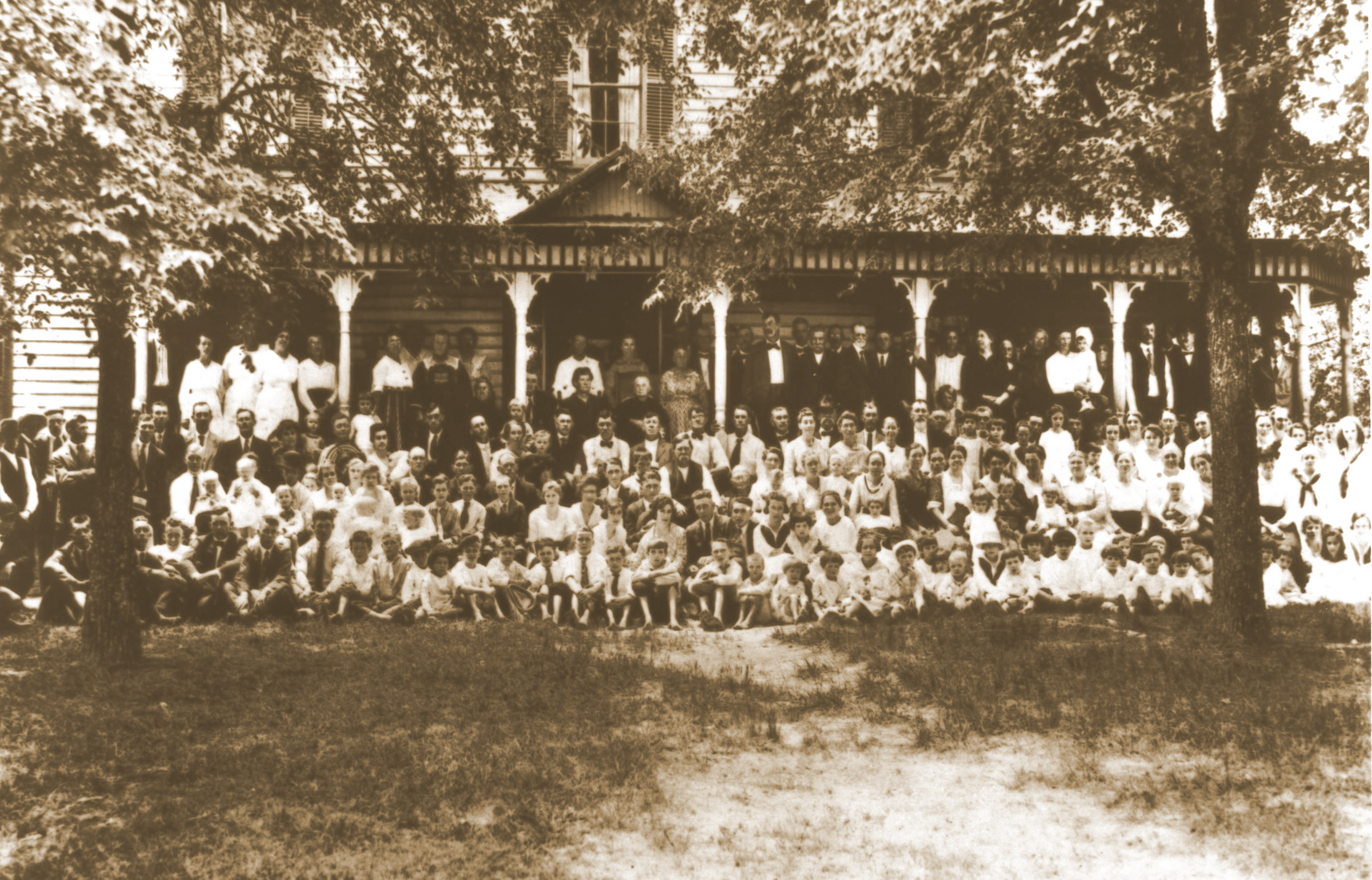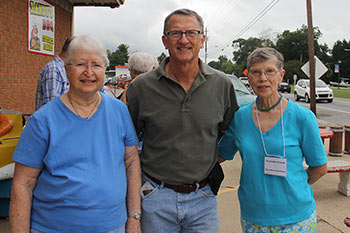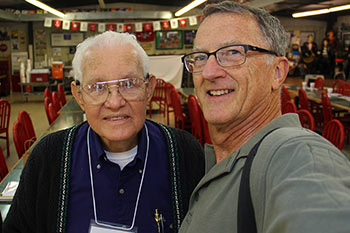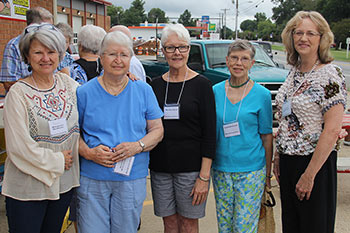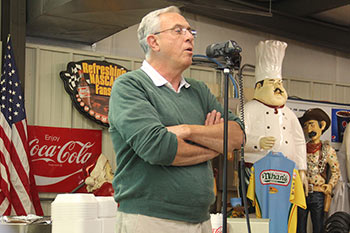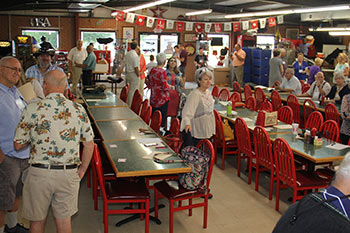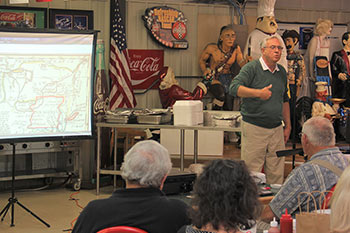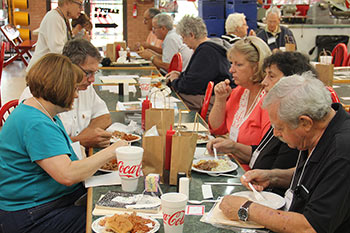CHAPTER 11
CONRAD LIPPARD'S WILL
Not many weeks passed before Seth excitedly reported that he had discovered in the Philadelphia Court House a will, dated 25 March 1753, and an estate inventory, dated 28 September 1754, for a Conrad Libert of Philadelphia County. Seth was excited about the possibility that Conrad Libert might actually be Conrad Lippard, especially since his will mentions a son named Wilhelm, the name of the other Lippard listed as a passenger on the Queen Elizabeth. Seth was not aware that I had the copy of Conrad's signature from the Queen Elizabeth's log. With that signature in hand, he was able to compare it to Conrad's signature on his will and determine without a doubt that the two signatures match. Although we have not been able to find any record of Conrad's death or burial in any church or civil records, nor have we been able to locate his tombstone in any cemetery, we are very excited at having Conrad's will and estate inventory, which tell us much more about Conrad than we had known and gives us our first information about Conrad's family and life after his arrival in Pennsylvania from Germany.
According to the ship's log, Conrad was 58 in 1738. Thus, he was born on September 21,1679. His will is dated March 1753 and probated in February 1755. However, his estate inventory is dated in September 1754 so he died in 1753 or 1754 at age 74 or 75. Because Conrad's original will is so difficult to read, I am including my (Harriet's) interpretation of it with words spelled as they appear to me.
Will and Order
Just Reliefs whereof I have hereunto Set my hand and Seal the day
And year above written Signed Sealed and Declared by the Said
Conerd Libert as his Last Will and order In the Presence of From: Register of Wills In and for the County of Philadelphia Pennsylvania, Conrad Libert Will, No. 48, 1753.
In the Name of God Amen this twenty fifth Day of March Anno. Domini 1753. I Conerd Libert of Hanover Township in the County of Philadelphia Being Aged and Infirm in body Containing Sound mind memory and understanding that it is appointed for all men once to Die Do make this to be my Last Will and Order touching such Worldly Estate wherewith it has Pleased God to bless me in this Life, Give Devise and Dispose of the Same in the following manner and form that is to say Imprimis. I Will and order that my Just Debts be paid and Discharged.
- I give to my Daughter Anna Martin [Martha] Wife of Henry Niman after the Disease of my beloved Wife the half of my Goods and Chattles to be to her proper use.
- I Give to Elisabeth Brown the other half of my Goods and Chattles to be to her proper use at her age of Eighteen years.
- I Give to my Son William Libert five Shilling and no more.
- I Will and order that Immediately after my Diseeas as Soon as may be that my Goods and Chattles be appraised and after the Diseeas of my beloved Wife that which Remains after her maintainance to be Sold and Devided in two Equal Shares the one to Anna Martin [Martha] and the other Share to Elisabeth Brown as aforesaid. Ratifying and Confirming this and no other to be my Last us the Subscribers.
Connard Lippardt
George Evans, Junr.
Michael Feadle
[Seal]
Conrad's Will was probated on February 19, 1755.
Analysis of Conrad's Will
What can we learn about Conrad and his family from his will? First of all, we learn that Conrad did have a "Wife" although he does not state her name, but we have been told by others on Ancestry.com that her name was Anna Maria Martin. We have been able to locate no will or estate papers for her and no church record or tombstone noting her death. It is in Conrad's Will that we learn for certain that his son is Wilhelm; we read that his daughter's name is Anna Martin, but that was obviously a confusion caused by the English clerk who wrote out Conrad's will and confused her real name Anna Martha with her mother's maiden name Martin. It is verified in church records in Pennsylvania that Conrad's daughter is actually Anna Martha. Additionally, we do not know if Conrad and Anna Maria are relatives of the young girl named Elisabeth Brown, less than eighteen years of age when Conrad died, who is also listed in his will and could be a grandchild by a deceased daughter, or even an orphan he and his Anna Maria took into their family. Conrad's Will provides that after his Wife's death, all his remaining goods and chattels that his Wife has inherited will be sold with the proceeds then divided between his daughter Anna Martha, who by this time is married to Heinrich Neiman (Neuman), and Elisabeth Brown, once she reaches the age of eighteen. Conrad wills no land to his descendants, and no land ownership records still exist in Philadelphia or Montgomery County for either Conrad or Wilhelm, leading us to believe that they were renters, unable to afford to purchase or locate affordable farms of their own in Pennsylvania, or perhaps in Conrad's case not being particularly interested in farming.
One of the puzzling provisions of Conrad's will is his statement that "I give to my Son William Libert five Shillings and no more." Should this lead us to think that Conrad and Wilhelm were estranged or at odds for some reason? Possibly, but not necessarily. Perhaps Wilhelm had already received his inheritance and moved south where land was more affordable. Once children were gone from the area their parents lived in, there was little point in bequeathing anything to them because their collecting it would be extremely difficult if not impossible. I have seen similar small bequests in families where the deceased's children had already immigrated to new locations. Most frequently, the first generation of German immigrants into Pennsylvania died there, and many of their children moved to better locations soon after their parents' deaths, but in cases where some grown children stayed behind with the parents, others often left while the parents were still living. Later discovered evidence indicates that Conrad was still living when Wilhelm's family left Pennsylvania, probably in 1751 or 1752. Conrad died in 1753 or 1754.
Unfortunately, we probably will never know for certain why Wilhelm inherited only five shillings from his father. But I have a theory. As I mentioned earlier, I do not believe that Conrad was particularly interested in farming. Yes, he had a few crops in the field and a small number of livestock, but it does not seem that if we have the correct Conrad here as our ancestor, that he grew up in an agricultural environment. Instead, nearly all of his relatives in Mittelhof/Gensungen were involved in an industrial pursuit – producing bricks. We do not know what Conrad did for a living during the time he left Mittelhof probably in his teens until immigrating to Pennsylvania, but once there he seems almost immediately to involve himself in another industrial pursuit. Conrad was, to use the German word, an "Ascherer" or an "Aschenfahrer," a maker of potash. He was a burner of wood to make potash for soap production or possibly in Germany for glass-making purposes. America's first and first- patented industrial product was potash which Conrad produced in his two furnaces to sell for the production of soap. It is not clear whether Conrad sold his potash to people who made soap in Philadelphia, or whether the potash was sold to manufacturers who shipped the potash to England where it was used in making soap needed to wash the wool from the booming English wool trade. My theory is that particularly because Conrad was becoming an old man, he wanted Wilhelm to work with him and eventually take over Conrad's potash business. Note in Conrad's Estate Inventory which follows all the equipment Conrad possessed for making potash rather than equipment for farming. It appears that Wilhelm instead was interested in going south to acquire less expensive land than that available in Pennsylvania, land for a prosperous farm to support himself and his family. I think Conrad was expressing his displeasure with Wilhelm's choice in essentially telling him that if he would not join Conrad, he would have to make it financially on his own. Wilhelm took up the challenge.
CONRAD'S ESTATE INVENTORY
Conrad's Estate Inventory was presented to the Court on 8 September 1754. From it we learn more about his life as a first generation colonist in Pennsylvania, living in what was then Philadelphia County but is now Montgomery County. Unfortunately, we do not know exactly where he lived because he apparently owned no land that we can trace through a land deed.
Because Conrad's estate inventory also is difficult to read, I am including my (Harriet's) interpretation of it with the original spellings and with blanks where I found it impossible to decipher a word.
A true and Perfect Inventory of the Goods and Chattles of Conerd Libert Late of Hanover Township in the County of Philadelphia Deceased Appraised by us the Subscribers this twenty Eighth Day of September A. Do. 1754 as followeth viz
| ITEM | ₤ | S | d |
|---|---|---|---|
| Wearing apparel | 2 | 0 | 0 |
| Cash in hand | 9 | 0 | 0 |
| Wooley yearn | 0 | 5 | 0 |
| 4 yards striped Lincy | 0 | 12 | 0 |
| 1 askeds Shochtel and Caps Shears | 0 | 2 | 6 |
| 4 Caps Shochtel | 0 | 8 | 0 |
| 2 Shirts 2 pair mittins & Sundrey | 0 | 7 | 0 |
| a Sceals beam waights Coblin Box | 0 | 4 | 0 |
| 3 bibles and other Books | 9 | 5 | 0 |
| 1 bag 1 basket and meal | 0 | 7 | 0 |
| an old chest | 0 | 10 | 0 |
| 2 pleats of Stove | 0 | 7 | 6 |
| old barrel Cag and Bucked | 0 | 9 | 0 |
| 2 old tubs 2 butter tubs old Bucked | 0 | 5 | 0 |
| 9 Iron potts freeing pann Ladle 1 plate 4 Spangs | 0 | 14 | 0 |
| old scellet trebelt wimble Lamp | 0 | 4 | 0 |
| 1 Bedd and Bedding 1 yard linen | 1 | 17 | 6 |
| Cuttery knife Box Dough traugh | 0 | 7 | 0 |
| Flax Seed Lumber old tubs & Sickels Greas pott | 0 | 10 | 0 |
| 20 busel of rey @ 3S=6d pr busel | 3 | 10 | 0 |
| 2 hogs | 1 | 10 | 0 |
| 1 Cow | 3 | 0 | 0 |
| one mare and Saddle and bridle | 5 | 12 | 0 |
| 2 barrels and a pice of Pott Ash old Hogsheads and troaghs | 5 | 0 | 0 |
| 2 Iron furnaces for to make pott ash | 6 | 0 | 0 |
| plow Irons gears Swiggle tree Clevises pleats | 0 | 10 | 0 |
| 1 ax 2 hoes Chains hopples Drawing knife | 0 | 12 | 0 |
| old Gun powder & horn and Sive and whetstone | 0 | 10 | 0 |
| 1 acre of buckwheat and hay and Straw | 0 | 18 | 0 |
| Half an acre of tarnips | 0 | 12 | 0 |
| 2 Sheep | 0 | 12 | 0 |
| Cash in the hands of Peter Woods | 1 | 0 | 0 |
| Cash in the hands of Henry Niman | 7 | 0 | 0 |
| 2 bells | 0 | 5 | 0 |
| Cash in the hands of Widow Spring | 0 | 3 | 0 |
| Appraisal by us as Witness our hands the | 48 | 7 | 6 |
| Day and Year above written | Henry Coulston William Brooke |
||
Conrad's Estate Glossary
Askeds shochtel -- ?
Beam waights – ?
Bucked – bucket
Busel – bushel
Cag – keg
Clevises pleats – a U shaped fastening device with 2 holes at the end for a pin or bolt to pass.
Coblin –cobbler's box
Freeing pan – frying pan
Hogheads – large casks
Hopples – hobbles, a fetter used on the legs of a horse or cattle to keep them in place.
Lincy – linsey-woolsey, a coarse twill or plain woven fabric.
Pleats – plates
Rey – rye
Sceals – scales
Scellet – skillet
Sive – sieve
Spangs – spoons
Swiggle tree (also called swingletree) – singletree, the bar between the pulling animal and the wagon or plow that balances the weight being pulled.
Tarnips – turnips
Trebelt -- ?
Traugh – trough
Troaghs – troughs
Whetstone – knife sharpening stone
Wimble – instrument for boring holes
Yearn -- yarn
Conrad's estate inventory reminds us of how little encumbered with worldly possessions most folks of Conrad's time and station were. He did have an ax possibly used for cutting wood used in making potash. However, it is worth noting that although Conrad owned relatively few personal possessions, he did own three Bibles (perhaps at least one in German and one in English?) and also other books, an indication that he was a religious and literate pioneer. As I noted earlier, he apparently did rent a farm because he owned a few head of livestock and did a little grain farming. One puzzling item in his inventory is his one-half acre of turnips. It is not surprising that no other garden crops, only grains for harvesting, are mentioned because his estate inventory was prepared in late September. By then it was too late for most vegetables still to be in the field, but it was not too late for turnips. However, with only three people in his household and only a few animals in his barn that might eat turnips, I am left wondering what in the world Conrad would have done with so many turnips! Did he just love turnips, or did he grow turnips for the entire neighborhood, especially because the entire turnip plant could be eaten by people or used for animal fodder. He may have even done a little more truck farming during the summers.
Pot Ash
The most interesting group of Conrad's belongings is his collection of equipment for making potash (2 pleats of stove, 2 barrels, two old tubs, 9 Iron potts, a pice of Pott Ash. old hogsheads, troughs, and two iron furnaces). The items in this group are more than twice as valuable as any of his other possessions. In colonial days "potash" was a term used to mean potassium carbonate, derived from burning hardwood. In this early period, the most frequent uses of potash were making glass, pottery glazes, and soap. It was also used to make fertilizer, but in a new land fertilizing crops probably was unnecessary.
However, I am inclined to doubt that glass or pottery making or any part of those cottage industries were the use for which Conrad made his potash. From a historical perspective as I mentioned earlier, potash was America's first industrial chemical. In fact, the first U.S. Patent, signed by first President George Washington himself, was issued on 31 July 1790, some 37 years after Conrad's death, to Samuel Hopkins of Philadelphia for several improvements in the procedures of making potash and pearl ash. The traditional method for producing potash was to burn in large outdoor fires hardwood from such trees as elm, ash, maple, hickory, beech, and basswood, which all have very high potash content. In the colonial period, obviously there was much wood available as farmers cleared their fields in order to plant crops. After burning these hardwood trees, the ashes were gathered and leached in large troughs. The resulting solution was then boiled down in kettles and melted into blocks of crude black potash. One of the major aspects of Hopkins' "innovative" procedure was to burn the raw ashes once more in a furnace before leaching. This second burning resulted in much greater carbonate formation apparently because the free carbon in the raw ashes was more completely oxidized and because the ashes were exposed to concentrated carbon dioxide gas from the furnace fire. Interestingly, it appears to me that Conrad was years ahead of his time in that even before the 1750's he was already using part of the method Hopkins called an "innovation" in 1790. As we can tell from his estate inventory, Conrad was already making his potash by burning ashes in his two furnaces over forty years before Hopkins applied for his patent for what sounds to be Conrad's procedure.
Having suggested that Conrad was not making his potash for use in glassmaking or pottery, let me again explain what industry I think he was manufacturing potash for. By 1750, there was a steady international demand for potash soap, especially in England where the wool trade was prospering. In fact by 1760 England needed several thousand tons of potash a year to produce potash soap especially needed to wash wool before it was woven into cloth for both use at home and sale in local and foreign markets. By the 1700's England had to a large extent depleted its own timber resources and thus had become dependent on purchasing potash from other countries, especially Russia. In an effort to save money, English industry established American potash works in port cities such as Boston, New York, and Philadelphia. England sent experts and manuals on potash production to the colonies and encouraged production with tariff incentives. These potash works were fed with potash purchased from both local residents and outlying farmers. Thus. it seems to me most probable that Conrad was producing potash for soap, potash which he sent to the Philadelphia potash works for eventual use in the English wool trade. As discussed earlier, Conrad probably brought this skill to America with him but that is impossible to prove without learning for certain more about Conrad's life in Germany after he left Mittelhof-Gensungen. (information concerning pot ash taken to some degree from the Philadelphia Yearbook 1917, published by the Philadelphia Chamber of Commerce, USA, and The Journal of the Engineer's Club of Philadelphia and Affiliated Societies, Vol. XXXIV, 1917.)
Summary of Conrad's family as we know it:
Conrad Lippard – born 1679 in Mittelhof, Gensungen, Germany; died. 1753 or 1754 in Hanover township, Philadelphia County, Pennsylvania.
His wife Anna Maria Martin
His children
Wilhelm born 1699 in Germany; died will dated in North Carolina 5 September 1781. His wife Catharina Elisabeth Neidhardt, their six children, and Catharina's brother Christian Neidhardt who possibly had a wife and family.
Anna Martha born c.1714 in Germany; died buried March 1780 in Montgomery County, Pennsylvania.
Other possible relatives are Elisabeth Brown and Johannes Gunckel (also spelled as Gunckell, Kunkel, and Konkell), the man on the ship's log listed consistently between Conrad and Wilhelm, often an indication of a family relationship. Also aboard the Queen Elizabeth were two other men who might also be relatives – Johanes Gunckel (also spelled as Conkell and Kunkel) and Johan Georg Gunkel (also spelled as Konkell).
Although we have found no church records or tombstone for Conrad at Faulkner Swamp, it would seem that he probably lived not far from his son Wilhelm and his daughter Anna Martha in New Hanover Township, Montgomery County. Montgomery was carved out of Philadelphia County; Conrad's will was written in Hanover Township, Philadelphia County, which was probably changed to New Hanover when the new county of Montgomery was created. Although we did not find records or a tombstone for Conrad at Faulkner Swamp, we did find in the church records, entries recoding the deaths of Anna Martha and Heinrich Neiman.
Another Point of View
Conrad's Fate: "Location, Location, Location!"
In 1738, the city of Philadelphia was the best portal to the best place in the New World. High Street, where the county courthouse was located, stretched across the city to the beckoning wilderness to the west and south. The street would soon be extended all the way to Augusta, Georgia—more than 700 miles, and become the second most important of all colonial roads. (The first was the postal route that followed the coast from Portsmouth, New Hampshire, to Savannah.) Literally, the horizon had few bounds, other than the Alleghanies to the northwest, where the Iroquois Nation defended a "dark and bloody ground" that stretched from the Great Lakes to what became known as "cain-tucky". Life in Philadelphia for many was almost as good as life in London. Pennsylvania, anchored by its new statehouse, completed in 1736, was the best run colony in British North America. The Lippards likely walked by it as they headed off to their new lives. This, of course, would become Independence Hall, the repository all most of the values that brought our family to the western side of the Atlantic world.
But, how did they feel that day, most likely not too independent? Perhaps homesick, certainly trepidatious. Nothing was certain that day except they were no longer being heaved about in the small ship in a giant sea. How soon (or to what degree) would they get a leg up in their new home land?
Their political, social, and economic statues had to be in flux. When Conrad and Wilhelm Lippert took the oath of allegiance to George the Second, king of the United Kingdom and elector of Hanover, they pledged to be loyal to their new country, so to speak, but said little about their loyalty to their heritage as Germans. It is likely that, they, like other emigrants from the Palatinate, simply saw themselves as a part of a transplanted colony serving an English king who still spoke German. (Even in North Carolina, all the first Germans to arrive were referenced as "Dutchmen", a play upon their word for Germany). Their second oath, however, to be loyal and obedient servants of Pennsylvania, started them on the road to full participation in what became "the American dream" in the most successful of the Thirteen Colonies. This theme will be explored in this chapter, that focuses on the life and times of "Willam", as Wilhelm once had his name spelled. Figure 13.3 Gary Freeze in Philadelphia
Wilhelm/Willam/William could actually have high expectations for life in this new place, for himself and his family.
First, there was what later folklorists would term "the Goldilocks effect" when it came to the new environment. To the north, in New England, the weather was too cold (the period has been called a "mini-ice age"), so cold that mold often ruined the wheat crop. To the south, the heat made generalized farming more difficult; and in addition, the presence of slaves in the coastal areas of Virginia and the Carolinas lowered the wage paid most forms of labor. In contrast, crops like wheat, rye, and oats grew so well in what were called "the Middle Colonies" that farmers often could get enough help to do the harvest. Plus, the closeness of markets like New York, Philadelphia, and (in 1738) the new port of Baltimore meant that marketing whatever one had to sell was relatively easy, compared to most everywhere else. Once upon a time, New Jersey was actually "the garden state". No fable. So, the restrictions on work and reward were less than back in the Rhineland.
Second, William Penn, the Anglican aristocrat turned unquarrelsome Quaker, had promised tolerance of belief and behavior in both the market place, six days a week, and at "the meeting house" on the Sabbath. In fact, in the Quaker colony one could even choose Saturday to be the Sabbath, as did Germans known as "Tumblers", more properly Dunkers, who practiced their Baptist faith on the sixth day of the week. There were more "Sectarians"—the word used then for folks who set up their own religious belief systems (within a Christian framework)—in Pennsylvanians then there were places to worship. One group of "monks", who lived to the west of the city of Philadelphia, even used a cave for their devotions, in between their nocturnal strolls—according to legend naked, before donning clothes to be gardeners in Germantown during the daytime. Another "cloister" at Ephrata, west of the city, had men and women dress alike in tow cloth, hummed in unison as they worked, and slept, in separate cells with pieces of wood as pillows. So, the Lippards likely knew they would have the choice to keep their religio-cultural identity, or venture forth toward a new one.
There was a caveat here, however, that bears mention. Ethnic prejudice was as accepted as class privilege in colonial settlement, and Germans were part of society, but not in its higher ranks. Benjamin Franklin, who worried that there would not be enough white people in the world of the future, looked down his nose—he had not yet invented bifocals—at the "swarthy" Germans. "Those who come" from the Palatinate, he observed, were "generally of the most ignorant stupid sort of their own nation". It is doubtful that the Lippards once they ventured down High Street stopped in at the nearby Franklin print shop and got a few candles made by Ben's Boston relatives, but it could have happened.
Still, and third, there was a large horizon of opportunity and support for a lot of the immigrants. The Lippards might have stopped at one of the two German churches located just blocks from the wharves, perhaps to give thanks or meet someone more like them. Germans made up a large minority of the whole area; Franklin saw them as the swing voters in local politics, because they had come and eagerly made their lives work for themselves and their greater community. Even the setting was beneficial. The hilly, well drained and wonderfully wooded territory north and west of Philadelphia was similar in slope and scope to the Palatinate back home, so it could seem like home, and one could prosper perhaps even better than back home. Even the Delaware River basin had the gravity of a Rhineland setting.
So, what happened first? Since Harriet and others have found no real evidence that the Lippards got very prosperous in Pennsylvania, it is likely they were relatively poor upon disembarking from the ship. If the Lippards had paid the passage before they departed—we have no evidence either way—then they could take up their goods, etc., and head down High Street to their new lives. If, however, they had come over as debtors, they owed passage even for family members that may have died on the voyage. Some Germans were known to be "redemptioners", which meant that they were to find someone in the city who would pay the bills for the whole family, then would become laborers to pay back what was owed.
This was not like chattel slavery or indentured servitude practiced in other colonies. Redemptioners had negotiability in choosing their master, for a set period of time agreed upon at the docks. Most often, this meant that the whole family then set about with a set of tasks to perform, and their patron also became their landlord. The tasks could be agricultural, artisanal, or a mix of both.
We simply do not know what exactly happened first. They may have lived in the city for a while and worked off their passage. They may have had some employment agent step upon the gangplank and buy their labor for some farmer out in the countryside, in all likelihood another German. We have only two clues: 1) where they are found more than a decade later, and 2) what Conrad ended his life doing to make a living for himself and others.
The fact that the story of our line of Lippards begins at "Falkner Schwamm"—the original spelling on deeds—puts our family in the heart of one of the earliest German settlements. Faulkner Swamp—its Anglification; "schwamm" actually means meadow in that era's German—was home to more than 100 farms and families, in a landscape that probably produced enough traffic and truck to hire skilled folks like the Lipperts. Neither Seth nor Harriet ever found a deed for a Lippard farm in the area because, possibly, they were still paying off the redemption, and two, life worked pretty well for a time as "renters" of both their homes and their labor. Since quite often Germans came over as groups—they often called the small migrations "colonies"—then it could be that the Lippards already knew where to go once they arrived.
The clues from Conrad's will also support such a supposition. He was a potash maker in Pennsylvania, as his inventory of worldly goods attests. (We cannot tell if he came to America as one; there was no guild or apprenticeship involved.) He seemed to own the means of a small production shop, with his "3 furnaces" and other tools. Potash was in great demand—Massachusetts even set up a subsidy for its manufacture—for everything from soap to gunpowder to glass to cooking, and Pennsylvania became the early center of production. Market conditions were such, in the 1740s, that Conrad would not have had a problem with selling his production to someone on the wharves. He might have even ventured into the Franklin print shop occasionally; Debbie Franklin sold soap that she herself made in the print shop, so who knows?
Had Conrad lived a bit longer he would likely have done business at a large facility that stored the potassium carbonate in a Dock Street warehouse. It was opened with great fanfare and expectation in 1754, the same year that Conrad's will is probated.
There is a second clue from the family that suggests how well they were doing in the Falkner Swamp area. There were lots of trees there, many of which was being girdled, left to die, then cut down to make way for farm fields. Conrad's son and grandsons might easily have started life in the New World as wood cutters in the various neighborhoods of their communities. Wood cutting was essential to providing both food and fuel for the new settlers, and often debts were worked out by such day labor. (We will see below a clue that William was a woodcutter!) And, Conrad might have had the surplus wood—at least the branches to char and render the ashes needed for the leaching of the alkaline that make potash. They may even have travelled about like other itinerant artisans like cobblers, since potash was in such demand.
Conrad clearly was renting a small plot of land when he died, about 1754, as testified by the listing of twelve acres of turnips in his inventory. These tubers took no work once the seeds were successfully germinated, and they could stay in the ground most of the winter, even in the little Ice Age of the time. Turnips were often fed to hogs, another way to work off debt in the neighborhood, or they made good truck to have in the market cart taken to Philadelphia.
So, although Conrad was not wealthy, he did not do poorly in his new environment. And, we can speculate, given what little we know about the early adulthood of William, that he also prospered in that rich area. First, William will acquire a goodly amount of land to farm once he moves south (as will John), and there had to be some kind of credit system at work here, where there was enough realizable capital to fund such ventures. (Rarely did most families just head south with not much of anything; John Knox, for example, the great grandfather of the United States President James Knox Polk, was noted as a horse trader along the Great Wagon Road. He literally was like a service station attendant to keep people heading down the road. The Adam Sherrill family had the nickname Conestoga, an indication that they could repair and restore the covered wagons that made the road south so "great".)
That William in his middle age may have had some means is one of the clues about a puzzle in Conrad's will: that William "got five shillings and nothing more". That could mean any of several conditions, from the extreme that William was a poor son who did not take care of his elder to the other idea that William's work to end the possible redemption led to enough savings to venture out on his own, in a better location for someone who did not have a good Faulkner Swamp property. That would have meant that Conrad had succeeded in one of the most important components of life in early America: "setting up" one's children to go have their own lives.
So, we have to speculate that given Conrad did as well as he did—coming to America in what was then his old age—that the American dream was at work, at least in the second and third generations of immigrants: The son did better than the father, and the next son did even better, as we shall see.
Before venturing south, we need to place the Lippards a little more precisely within Pennsylvania Dutch culture. This involves understanding the clear link to the Faulkner Swamp community, since William and Catherine had some of their children baptized and confirmed there. John, etc. This was done in the German Reformed congregation connected to the neighborhood. Since we cannot place the Lippards within the "old order" of the Reformed church in Germany—at least not yet—we can only speculate that they chose such a congregation because of their background. Given that John will be a trustee for a church in North Carolina that imitated in style the nearby Goshenhopper Reformed Church, we can be fairly confident of some kind of choice was made and stuck to.
They clearly seem to have respectable members of the congregation. Bear in mind, with all the sectarians running about, and even self-proclaimed men of God saying they can preach or just go hide in caves, this was a decision that was conservative and proper. Being in the Reformed Church meant that the Lippards had chosen to be "Church People", a reference to the old parish identity back in Germany. This proprietary stance often resulted, said one observer of the scene, that "the Sectarians often made the Reformed people the object of their ridicule." Even Faulkner Swamp itself could be vulnerable at times in the period. It was said a few years before the Lippards arrived that "our own free will was best" in shaping the faith journey, an anathema to a real Calvinist "holding to the old confession," as the Faulkner Swamp pastor, Johannes Jacob Boehm, explained to church officials back in Europe.
The respectability factor is evident from the marriage and subsequent settlement of Conrad's daughter Anna Martha to Johan Heinrich Neiman, a cobbler and a member of a large respectable Neiman family in the Faulkner Swamp community.



